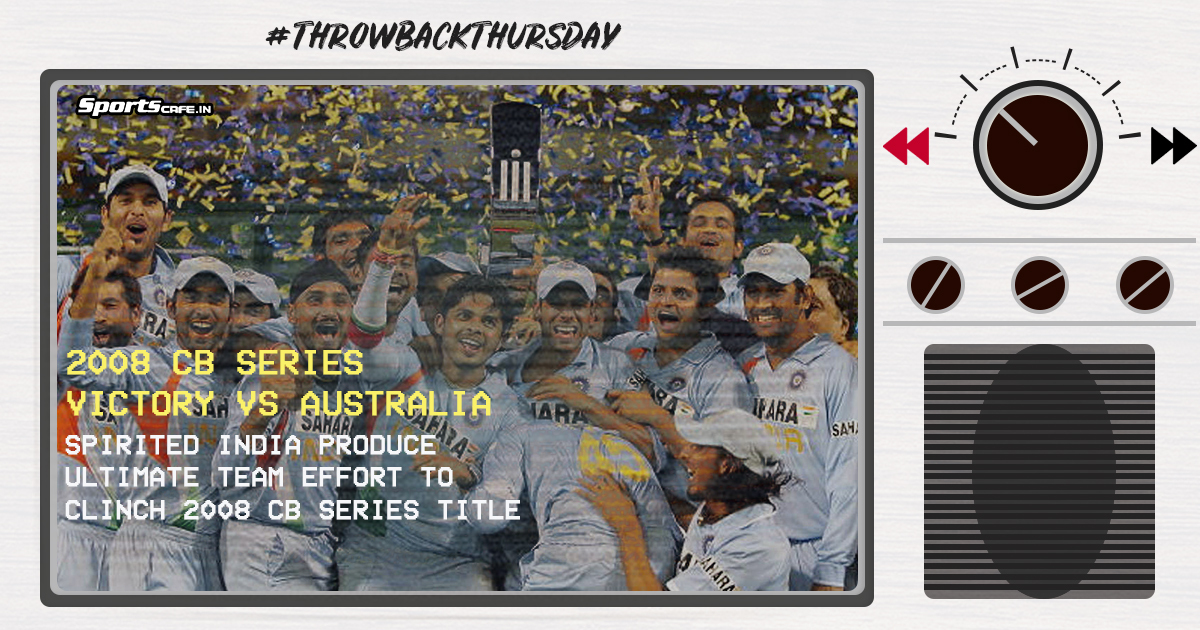Throwback Thursday | Spirited India produce ultimate team effort to clinch 2008 CB series title
Welcome to the series where we present you a moment, a game in history that has shaped the way the sport has been played, in our weekly segment ‘Throwback Thursday.' This week we reminisce about the second final of the 2008 CB series, where India created history by conquering Aussie-land.

It’s March 4, 2008, and we’re at the Gabba in Brisbane for the second final of the 2008 CB Series, with India having already won the first one. Brisbane it says, but you will be forgiven for mistaking it for Brabourne or Barabati, for wickets are being cheered more than boundaries and the sea of blue has outnumbered its yellow counterpart by more than double. Separating India and a maiden tri-series win Down Under is 3 balls, but standing as a barricade between themselves and victory is Australia’s last Hope(s), James. The passionate Aussies in the stadium, who know a defeat is imminent, are hoping against hope while rooting for Hopes, and are keen to cast a spell on Irfan Pathan, who is, currently, their biggest enemy.
But before we could unspool the tape and reveal who destiny favoured, it is imperative that we rewind and understand how we got to this point in the first place.
The traditional ODI tri-series in Australia that usually succeeds the Tests, is generally viewed by teams and fans as a rather light-hearted conclusion to an intense summer but India, in 2008, were having none of it. For them, it meant a hell lot more. For starters, they were screwed over by the officials, badly, and that cost them the Test series, but their pride and dignity had been besmirched by the Monkeygate Scandal. The Harbhajan-Symonds controversy, in fact, led to the Men in Blue threatening to abruptly walk out of the tour. Eventually, they didn’t, but tempers were flaring three months into the tour; there was no love lost.
However, it was not just the umpiring and the Monkeygate scandal that stirred controversy. The omission of Sourav Ganguly from the limited-overs leg superseded everything as the ‘Hot topic of controversy’ and the selectors and captain MS Dhoni’s decision to give precedence to youth, at the expense of overlooking icons, rubbed a lot of people the wrong way. So India, heading into the limited-overs, were under pressure to avenge the injustice that was served to them a month back - not just externally, but also internally.
Revenge was what the young guns, led by Dhoni, were after but to the entire contingent’s utter horror, the team were bowled out for a sickening 74 in the only T20I that preceded the Tri-series, setting the worst tone imaginable, heading into the ODIs.
But surprisingly, the Men in Blue quickly shrugged the defeat off. After a no-result in match one of the month-long tournament, India humiliated the hosts at the Mighty G a week later, courtesy two youngsters - Ishant Sharma and Rohit Sharma - to draw first blood in the tournament. And this - youngsters stepping up their game under pressure - as it turned out, would go on to be a fascinating sub-plot in the entire competition. Rohit Sharma, Robin Uthappa, Praveen Kumar, and Ishant Sharma, all either in their teens or in their early 20s, would make invaluable contributions at crucial junctures to keep the boat afloat, and the dream alive.
But despite the unexpected result at the G, a change in fortune for both countries did not ensue. The Aussies went on to win four of their next five games, including an 18-run victory against India in Sydney, to soar into the final, while the Men in Blue registered just two more wins. But those two wins turned out to be pivotal as they came against Sri Lanka, who they were directly competing with for a spot in the final. A handsome seven-wicket in Hobart against the Lankans, which, again, were initiated by 8 wickets from youngsters Ishant and Praveen Kumar, propelled India into the Tri-Series final for just the third time in their history. The date, and subsequently the showdown with the Aussies, had been set.
Now the CB series final was unlike any other - it featured a best-of-three format which eliminated the luck factor to ensure that the best side prevailed. So as if the task wasn’t mountainous already, the format made it next-to-impossible for the visitors, who had at hand the challenge of toppling the world champions twice in three games in their own backyard.
Indian sides of the past might have conceded defeat and admitted that the task that lay in front of them was unconquerable, but not this one. This was, after all, the very team which, under the leadership of Dhoni, had defied all odds to lift the World T20 title just over six months ago.
There, youth and energy was all they had, but here they had one more invaluable entity: experience. A blend of youth and experience, they say, is the perfect recipe for success and the statement proved to be true in the first final in Sydney, where an astounding 123-run stand between 34-year-old Sachin Tendulkar (117*) and 20-year-old Rohit Sharma (66) helped the visitors coast to a stunning six-wicket victory to go 1-0 up in the finals.
This was uncharted territory for India, but not for the Aussies who, only the previous year, had suffered a 2-0 loss in the finals at the hands of England. So while India entered the second final in Brisbane wanting to script history - wanting to win the Tri-Series for the first time in their history - the Aussies’ ulterior motive was to save embarrassment and drag the contest to the decider.
And two thirds into the game, they looked like they were well on their way towards enforcing final number three. Despite a 91-run onslaught from Sachin, the hosts kept India down to 258, and, in response, were storming at 121/3 in the 25th over, with powerhouses Hayden and Symonds in the midst of an 89-run stand. But a calamitous run-out would turn the match on its head. 121/3 would soon become 123/5 and despite his best efforts, Mike Hussey would perish for 44, leaving James Hopes as the last man standing, with Australia 199/6, still needing 60 runs off the last 8 overs to stay alive in the tournament.
India, at this point, knew they were favorites, but what they did not know was how much damage Hopes could inflict on them. Hopes batted at No.7 and he’d had a lean Tri-series until then, yes, but he was an absolute monster; it was only months ago in the Ford Ranger One Day Cup, for Queensland, he’d smashed 215 runs @ an average of 71.66 and an SR of 120.78. And on the day, the all-rounder brought to the stage some of that hitting.
Despite wickets tumbling at the other end, Hopes, ice-cold, kept his calm and inflicted calculated damage on the Indians. He ran smartly, targeted the right bowlers, and kept the required run rate in check. Through his acumen, and, of course, brute power, he brought the equation down to 13 needed off 6 balls - single-handedly.
Two lusty blows, from hereon, was all that was needed for the Aussies to take the finals into a decider but tragedy would ensue in the first two balls as after Hopes could only manage a single off the first ball, Bracken, on the second, would scoop one right into the palms of Piyush Chawla. 12 was needed off the last 4 balls but one wicket was all that was remaining, so Hopes needed to play it out smartly. On ball 3, he would dig out a fine yorker from Pathan to long-off to collect two runs to bring the equation down to 10 needed off 3 balls.
So that brings us to the moment.
The game, series and Australia’s proud legacy rests in the hands of Hopes, who, with two mighty hits, can inch closer to being seen as ‘that’ all-rounder Australia have been waiting for, for two decades. This is alien territory for him, but not so much for his counterpart, Irfan Pathan, who only six months ago dished out a Man of the Match performance in a World Cup final. But the magnitude of this occasion is such that Irfan would not think twice about swapping his ‘MOTM’ award for a victory here. One good ball, one wicket, he knows, will seal the title for India, but will, importantly, also ease the pain that they have endured over the course of their four-month stay Down Under; pain that’s unerasable. These next few moments are more than just normal deliveries; they are a pathway to script a new chapter in the country’s cricketing history. This is it.
Welcome to a moment in history.

Comments
Sign up or log in to your account to leave comments and reactions
0 Comments